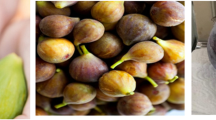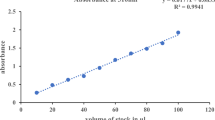Abstract
Bird’s eye chilli (Capsicum frutescens L.) is one of the most important species of the genus Capsicum, and is grown and consumed widely across north-east India, particularly in the states of Mizoram and Manipur. The bioactive compounds present in this landrace of north-east India are very less studied. The antioxidant property was assayed by scavenging abilities using diphenyl-2-picrylhydrazyl (DPPH), azinobisethylbenzothiazoline-6-sulphonic acid (ABTS), assay of ferric reducing antioxidant power (FRAP), and determining total phenolics (TP) and total flavonoids (TF) contents. There was a significant variation in the total phenolic content (12.4–133.2 mg GAE/g dry weight), total flavonoid (22.1–58.8 mg quercetin/g dry weight), DPPH (0.5–6.1 mM AAE/g dry weight), ABTS (20.5–44.3 mM AAE/g dry weight) and FRAP (0.7–7.8 mM GAE/dry weight) antioxidant capacity in Capsicum frutescens L. landraces. Two landraces of Capsicum chinense viz. MN-1 and MN-2 exhibited highest values for all the antioxidant assays. Positively significant correlation coefficients were observed between ABTS–FRAP, TF–FRAP, TP–FRAP, TP–DPPH and TP–TF. From principal component analysis (PCA) first two PCs explained 67.3 % of total variance and it was contributed mainly by TP, TF, ABTS and FRAP activities. Seventy-two Capsicum landraces were grouped into five clusters based on the standardized squared Euclidean distance using Ward’s hierarchical clustering method and separation based on PCA biplot. The experiment established that the landraces of Capsicum frutescens L. are potent source of natural antioxidants which reduce the oxidation processes in the body by protecting against reactive oxygen species.


Similar content being viewed by others
References
Shi HL, Noguchi N, Niki E (2001) Introducing natural antioxidants. In Pokorny J et al (eds) Antioxidants in food: practical applications. Woodhead Publishing Ltd. and CRC Press, UK
Faustino JMF, Barroca MJ, Guine RPF (2007) Study of the drying kinetics of green Bell pepper and chemical characterization. Food Bioprod Process 85(C3):163–167
USDA Nutrient Data Laboratory (2007) USDA national nutrient database for standard reference. 1 May 2007. http://www.nal.usda.gov/fnic/foodcomp/search
Ferrari CKB, Torres EAFS (2003) Biochemical pharmacology of functional foods and prevention of chronic diseases of aging. Biomed Pharmacother 57:251–260
Pruthi JS (1980) Spices and condiments. In Chichester EM, Stewart GF (eds) Advances in food research. Academic Press, New York, p 13
Heiser CB Jr, Pickersgill B (1969) Names for the cultivated Capsicum species (Solanaceae). Taxon 18:277–283
Heiser CB Jr, Smith PG (1953) The cultivated Capsicum peppers. Econ Bot 7:214–226
Export-Import Bank of India (2009) Mizoram: export potential and prospects, Ocassional paper No. 135
Nayar MP (1997) Hot-spots of plant diversity in India strategies. In: Pushpangadan P, Ravi K, Santosh V (eds) Conservation and economic evaluation of biodiversity, vol 1. Oxford and IPH Publishing House, New Delhi, pp 59–60
Emmanuel-Ikpeme C, Henry P, Okiri OA (2014) Comparative evaluation of the nutritional, phytochemical and microbiological quality of three pepper varieties. J Food Nutr Sci 2(3):74–80. doi:10.11648/j.jfns.20140203.15
Rahim RA, Mat I (2012) Phytochemical Contents of Capsicum Frutescens (Chili Padi), Capsicum Annum (Chili Pepper) and Capsicum Annum (Bell Peper) Aqueous Extracts. In: 2012 International conference on biological and life sciences IPCBEE, vol 40 (2012) © (2012). IACSIT Press, Singapore, pp 164–167
Shotorbani NY, Jamei R, Heidari R (2013) Antioxidant activities of two sweet pepper Capsicum annuum L. varieties phenolic extracts and the effects of thermal treatment. Avicenna J Phytomed 3(1):25–34
Frary A, Kecxeli MA, Okmen B, Sxigva HO, Yemenicioglu A, Doganlar S (2008) Water-soluble antioxidant potential of Turkish pepper cultivars. HortScience 43(3):631–636
Ozgur M, Ozcan T, Akpinar-Bayizit A, Yilmaz-Ersan L (2011) Functional compounds and antioxidant properties of dried green and red peppers. Afr J Agric Res 6(25):5638–5644
Harborne JB (1973) Phytochemical methods. Chapman and Hall, London, pp 49–188
Ordon-ez AAL, Gomez JD, Vattuone MA, Isla MI (2006) Antioxidant activity of Sechium edule (Jacq.) Swart extracts. Food Chem 97:452–458
Susanti D, Sirat HM, Ahmad F, Ali RM, Aimi N (2007) Antioxidant and cytotoxic flavonoids from the flowers of Melastoma malabathricum L. Food Chem 103:710–716
Arnao MB, Cano A, Acosta M (2001) The hydrophilic and lipophilic contribution to total antioxidant activity. Food Chem 73:239–244
Wong C, Li H, Cheng K, Chen F (2006) A systematic survey of antioxidant activity of 30 Chinese medicinal plants using the ferric reducing antioxidant power assay. Food Chem 97(4):705–711
SPSS Inc. (2007) SPSS base 16.0 for windows user’s guide. SPSS, Inc., Chicago
Materska M, Perucka I (2005) Antioxidant activity of the main phenolic compounds isolated from hot pepper fruit (Capsicum annuum L.). J Agric Food Chem 53:1750–1756
Rawat S, Jugran A, Giri L, Bhatt ID, Rawal RS (2011) Assessment of antioxidant properties in fruits of Myrica esculenta: a popular wild edible species in Indian Himalayan region. J Evid Based Complementary Altern Med 2011:512787. doi:10.1093/ecam/neq055
Hervert-Hernandez D, Sayago-Ayerdi SG, Goñi I (2010) Bioactive compounds of four hot pepper varieties (Capsicum annuum L.), antioxidant capacity and intestinal bioaccessibility. J Agric Food Chem 58(6):3399–3406
Marin A, Ferreres F, Tomas-Barberan FA, Gil MI (2004) Characterization and quantisation of antioxidant constituents of sweet pepper (Capsicum annuum L.). J Agric Food Chem 52(12):3861–3869
Antonious GF, Kochhar TS, Jarret RL, Snyder JC (2006) Antioxidants in hot pepper: variation among accessions. J Environ Sci Heal B41:1237–1243
Zimmer AR, Leonardi B, Miron D, Schapoval E, Oliveira JRD, Gosmann G (2012) Antioxidant and anti-inflammatory properties of Capsicum baccatum: from traditional use to scientific approach. J Ethnopharmacol 139:228–233
Mohanty AK, Kumar A, Nath BG, Lepcha B, Pathak PK (2012) Studies on ethno-veterinary plants used by Lepcha community in Sikkim. In: Book of extended summaries. The National Seminar on Livelihood Options for Small and Marginal Farmers in Fragile Ecosystems. ICAR Research Complex for NEH Region, Umiam, 793 103, Meghalaya, pp 173–176
Lutharia DL, Mukhopadhyay S (2006) Influence of sample preparation on assay of phenolic acids from eggplant. J Agric Food Chem 54:41–47
Burton-Freeman B (2010) Postprandial metabolic events and fruit-derived phenolics: a review of the science. Br J Nutr 104(Suppl. 3):S1–S14
Valery M, Dembitsky Poovarodom, Leontowicz H, Leontowicz M, Vearasilp S, Trakhtenberg S, Gorinstein S (2011) The multiple nutrition properties of some exotic fruits: biological activity and active metabolites. Food Res Int 44:1671–1701
Kordali S, Cakir A, Mavi A, Kilic H, Yildirim A (2005) Screening of chemical composition and antifungal and antioxidant activities of the essential oils from three Turkish Artemisia species. J Agric Food Chem 53:1408–1416
Wolfenden BS, Willson RL (1982) Radical-cations as reference chromogens in kinetic studies of one-electron transfer reactions: pulse radiolysis studies of 2,29-azinobis-(3-ethylbenzthiazoline-6-sulphonate). J Chem Soc Perkin Trans 2:805–812
Benzie IEF, Strain JJ (1999) Ferric reducing/antioxidant power assay: direct measure of the total antioxidant activity of biological fluids and modified version for simultaneous measurement of total antioxidant power and ascorbic acid concentration. Methods Enzymol 299:15–27
Martysiak-Żurowska D, Wenta W (2012) A comparison of ABTS and DPPH methods for assessing the total antioxidant capacity of human milk. Acta Sci Pol Technol Aliment 11(1):83–89
Wu L, Hsu H, Chen Y, Chiu C, Lin Y, Ho JA (2006) Antioxidant and antiproliferative activities of red pitaya. Food Chem 95:319–327
Arnao MB (2000) Some methodological problem in the determination of antioxidant activity using chromogen radicals: a practice case. Trends Food Sci Tech 11:419–421
Rawat S, Bhatt ID, Rawal RS, Nandi SK (2014) Effect of developmental stage on total phenolics composition and anti-oxidant activities in Hedychium spicatum Buch.-Ham. ex. D. Don. J Hortic Sci Biotechnol 89(5):557–563
Bahukhandi A, Rawat S, Bhatt ID, Rawal RS (2013) Influence of solvent types and source of collection on total phenolic content and antioxidant activities of Acorus calamus L. Natl Acad Sci Lett 36(1):93–99. doi:10.1007/s40009-012-0109-8
Rufino MDSM, Alves RE, Brito ESD, Pérez-Jiménez J, Saura-Calixto F, Mancini-Filho F (2010) Bioactive compounds and antioxidant capacities of 18 non-traditional tropical fruits from Brazil. Food Chem 121:996–1002
Contreras-Calderóna J, Calderón-Jaimes L, Guerra-Hernández E, García-Villanova B (2011) Antioxidant capacity, phenolic content and vitamin C in pulp, peel and seed from 24 exotic fruits from Colombia. Food Res Int 44:2047–2053
Iezzoni AF, Pritts MP (1991) Applications of principal component analysis to horticultural research. HortScience 26(4):334–338
Jaime GC, Luigi CP, Andrea CC, Fernando MS, Heidi SS, Emilio HU, Emma BT, Miren AL (2010) Antioxidant capacity, anthocyanins, and total phenols of wild and cultivated berries in chile. Chil J Agric Res 70(4):537–544
Koley TK, Kaur C, Nagal S, Walia S, Jaggi S, Sarika (2011) Antioxidant activity and phenolic content in genotypes of Indian jujube (Zizyphus mauritiana Lamk.). Arab J Chem. doi:10.1016/j.arabjc.2011.11.005
Acknowledgments
This research was financially supported by Indian Council of Agriculture Research (ICAR), New Delhi, India. The authors acknowledge Dr. S.V. Ngachan, Director, ICAR RC NEH Region, Meghalaya for his technical assistance and providing necessary facilities.
Author information
Authors and Affiliations
Corresponding author
Ethics declarations
Conflict of interest
There is no conflict of interest in any form with anyone for this work.
Rights and permissions
About this article
Cite this article
Dutta, S.K., Singh, S.B., Saha, S. et al. Diversity in Bird’s Eye Chilli (Capsicum frutescens L.) Landraces of North-East India in Terms of Antioxidant Activities. Proc. Natl. Acad. Sci., India, Sect. B Biol. Sci. 87, 1317–1326 (2017). https://doi.org/10.1007/s40011-016-0707-1
Received:
Revised:
Accepted:
Published:
Issue Date:
DOI: https://doi.org/10.1007/s40011-016-0707-1




